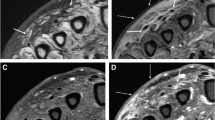Summary
Between March 1991 and February 1992 serial serum C-reactive protein (CRP) levels were measured prospectively for three weeks in 57 consecutive patients with fractures of long bones, and also in 11 patients who had undergone primary total hip or knee arthroplasty. A semi-quantitative capillary floculation method was used for measuring the CRP level. The highest values were usually recorded 2–3 days after trauma or operation, and the CRP was nearly normal by three weeks. In the patients with long bone fractures the amplitude of CRP response was affected by the type of treatment. Lower values were observed in those patients treated conservatively than in those who underwent operation, but the profile of CRP response was similar, regardless of the type of treatment. The CRP response was also affected by the severity of the trauma in conservatively treated patients, but in those who underwent operation the CRP response was similar, regardless of the severity of the injury. In patients with primary total hip or knee arthroplasty the pattern of CRP response after operation was similar to that in the patients with long bone fractures who underwent surgical treatment. Awareness of the natural course of the CRP response after fracture and arthroplasty may help in the diagnosis of early post-traumatic and postoperative complications, especially infections.
Résumé
Du mois de Mars 1991 au mois de Février 1992 le taux sérique de la C-réactive protéine (CRP) a été mesuré de façon prospective pendant trois semaines chez 57 patients consécutifs atteints de fractures des os longs ainsi que chez 11 patients opérés pour la première fois d'arthroplastie de la hanche ou du genou. On a utilisé pour mesurer la CRP une analyse semi-quantitative (méthode de floculation capillaire). Les chiffres les plus élevés sont en général enregistrés 2 ou 3 jours après le traumatisme ou l'opération et la CRP est quasiment normalisée en trois semaines. Chez les patients fracturés l'amplitude de la CRP varie selon le type de traitement: les valeurs les plus basses s'observent chez les patients traités orthopédiquement plutôt que chez ceux qui sont opérés, mais la courbe de la CRP est la même quel que soit le traitement. La CRP est aussi influencée par la sévérité du traumatisme (ouvert ou fermé) chez les sujets traités orthopédiquement, mais non chez ceux qui sont opérés. Chez les malades traités par arthroplastie le type de réponse de la CRP est semblable à celui des patients opérés pour fracture. La connaissance de l'évolution naturelle des taux de CRP après fracture et après arthroplastie peut aider au diagnostic des complications post-traumatiques et post-opératoires, et tout particulièrement des infections.
Similar content being viewed by others
References
Aalto K, Osterman K, Peltola H, Rasanen J (1984) Changes in erythrocyte sedimentation rate and C-reactive protein after total hip arthroplasty. Clin Orthop 184: 118
Dixon JS, Bird HA, Sitton NG, Pickup ME, Wright V (1984) C-reactive protein in the serial assessment of disease activity in rheumatoid arthritis. Scand J Rheumatol 13: 39
Fischer CL, Gill C, Forrester MG, Nakamura R (1976) Quantitation of “Acute-phase proteins” postoperatively. Value in detection and monitoring of complications. Am J Clin Pathop 66: 840
Forster IW, Crawford R (1982) Sedimentation rate in infected and uninfected total hip arthroplasty. Clin Orthop 168: 48–52
Kock-Jensen C, Brandslund I, Sogaard I (1988) Lumbar disc surgery and variations in c-reactive protein, erythrocyte sedimentation rate and the complement split product C3d. Acta Neurochir 90: 42
Kushner I, Gewurz H, Benson MD (1981) C-reactive protein and the acute-phase response. J Lab Clin Med 97: 739
Kallio P, Michelsson J-E, Lalla M, Holm T (1990) C-reactive protein in tibial fractures: natural response to the injury and operative treatment. J Bone Joint Surg [Br] 72: 615
Larsson S, Thelander U, Friberg S (1992) C-reactive protein (CRP) levels after elective orthopedic surgery. Clin Orthop 275: 237
Maury CPJ, Teppo A-M, Raunio P (1984) Control of the acute-phase serum amyloid A and C-reactive protein response: comparison of total replacement of the hip and knee. Eur J Clin Invest 14: 323
Mustard Jr RA, Bohnen JMA, Hasseb S, Kasina R (1987) C-reactive protein levels predict postoperative septic complications. Arch Surg 122: 69
Peltola H, Vahvanen V, Aalto K (1984) Fever, C-reactive protein, and erythrocyte sedimentation rate in monitoring recovery from septic arthritis: a preliminary study. J Pediatr Orthop 4: 170
Pepys MB (1981) C-reactive protein fifty years on. Lancet 21: 653
Shih L-Y, Wu J-J, Yang D-J (1987) Erythrocyte sedimentation rate and C-reactive protein values in patients with total hip arthroplasty. Clin Orthop 225: 238
Tillett WS, Francis T (1930) Serological reaction in pneumonia with a non-protein somatic fraction of pneumococcus. J Exp Med 52: 561
Vainionapaa S, Wilppula E, Lalla M, Renkonen O-V, Rokkanen P (1988) Cefamandole and isoxazolyl penicillins in antibiotic prophylaxis of patients undergoing total hip or knee-joint arthroplasty. Arch Orthop Trauma Surg 107: 228
Author information
Authors and Affiliations
Additional information
Reprint requests to: S.I. Yoon
Rights and permissions
About this article
Cite this article
Yoon, S.I., Lim, S.S., Rha, J.D. et al. The C-reactive protein (CRP) in patients with long bone fractures and after arthroplasty. International Orthopaedics 17, 198–201 (1993). https://doi.org/10.1007/BF00186386
Issue Date:
DOI: https://doi.org/10.1007/BF00186386




